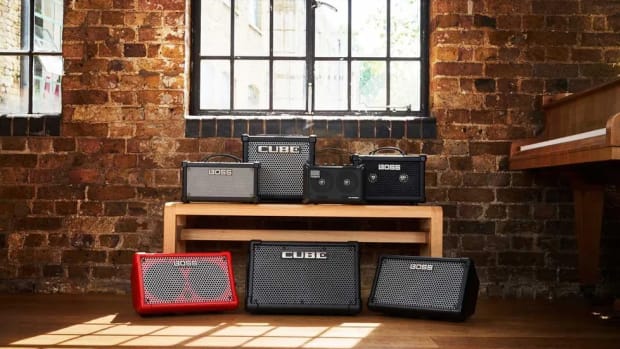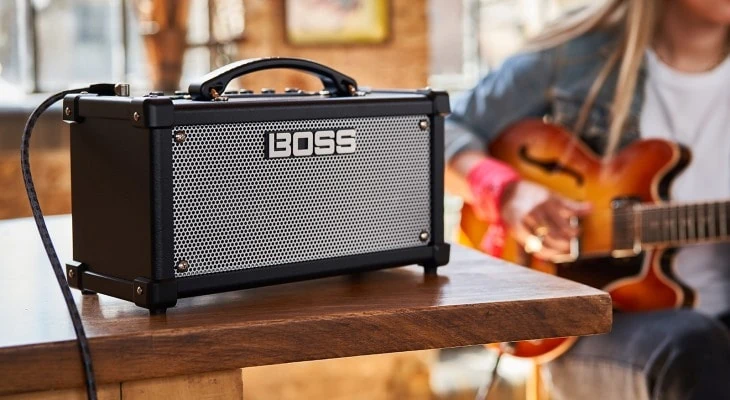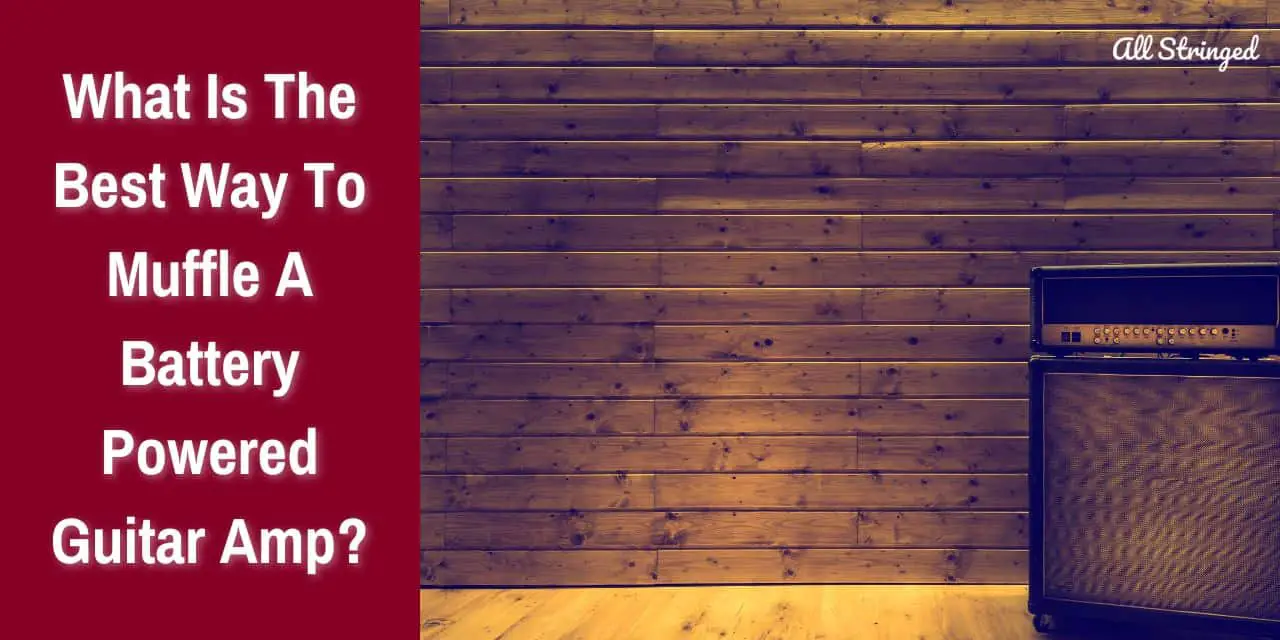Are you a guitar player looking for the best way to muffle your battery powered guitar amp? If so, you’ve come to the right place! In this article, we’ll show you the best way to muffle your amp while still preserving its sound quality. This is especially important when playing in environments that require a quieter volume. So without further ado, let’s dive in and discover the best way to muffle your battery powered guitar amp!
What do you mean by muffle in a battery-powered guitar amp?
For guitar enthusiasts, finding the perfect tone is an eternal pursuit. One of the key elements that shape the sound of an electric guitar is the amp. Battery-powered guitar amps offer portability and convenience for musicians on the go but they also come with unique characteristics that can impact the overall sound. One of these characteristics is “muffling”.
“Muffling” in the context of battery-powered guitar amps is a subtle reduction in the high-frequently response and overall brightness of the sound. When compared to their larger, mains-powered counterparts, battery-powered amps might exhibit a slightly softer or subdued tone, which can be attributed to design factors and power limitations. The muffling effect in battery-powered guitar amps can influence the tone in different ways.
>>> Click here to read our review about the Top 15 Best Battery-Powered Guitar Amps <<<
Muffling can cause a slight reduction in the treble frequencies, resulting in a smoother, warmer, and less aggressive tone. It can be desirable for certain genres of music or when a softer sound is preferred. The muffling effect can also impact the dynamics of overdrive and distortion. In some situations, it might result in a smoother and more compressed distortion, which can be useful for achieving a vintage or classic rock sound.
With the high-end frequencies slightly attenuated, battery-powered guitar amps might emphasize the midrange frequencies, adding a unique character to the overall tone. This midrange emphasis can contribute to a full-bodied and balanced sound.
The muffling effect in battery-powered amps is a trade-off for the convenience of portability. These amps are designed for running on batteries, which might not provide the same power and headroom as mains-powered amplifiers. While battery-powered amps offer unmatched portability for practice sessions, busking, or small gigs, they might not deliver the same tonal complexity as larger amps.
It is important for understanding that muffling in battery-powered guitar amps isn’t the same as a technical flaw or a defect. It is a natural consequence of the design choices made for creating a compact, portable, and battery-operated amp. In contrast, traditional, mains-powered amps often provide more headroom and a broader frequency response due to their larger power supply and speaker configurations.

What is the best way to muffle a battery-powered guitar amp?
Whether you are a musician or a guitarist, you should understand the importance of finding the perfect tone while respecting the peace and quiet of your surroundings. Muffling or soundproofing your battery-powered guitar amp can be important when practicing in shared living spaces, recording studios, or late-night jam sessions. This is why you might have the question – what is the best way to muffle a battery-powered guitar amp? There are multiple ways and the best option will depend from situation to situation. Here are the different ways you can muffle a battery-powered guitar amp.
Using a foam pad
Foam pads are an effective and straightforward solution for muffling your battery-powered guitar amp. They are readily available in various sizes and densities, and their lightweight nature makes them quite easy to handle and position. It is quite easy to use a foam pad to muffle a battery-powered guitar amp.
Place the foam pad under the amp. Position the foam pad under the guitar amp for creating a cushioning layer. This will help you minimize vibrations and resonance that might cause unwanted noise.
After that, elevate the amp. For additional sound isolation, it is recommended that you should elevate the amp slightly by placing it on top of the foam pad. This will further reduce direct contact with the floor or any other surface.
If your practice area has reflective surfaces like walls or hard floors, you should consider attaching foam panels to these surfaces. This will help you absorb sound reflections and reduce echo, resulting in a quieter environment.
Using a blanket
Using a blanket is a cost-effective and versatile method of muffling your battery-powered guitar amp. Blankets offer an extra layer of insulation that absorbs sound waves and reduces their transmission. It is very easy to use a blanket to muffle a battery-powered guitar amp.
Drape the blanket over the amp. By gently draping a heavy blanket over the amp, you will be able to ensure that it covers the sides and top completely. The weight and thickness of the blanket will help in dampening the sound and prevent sound leakage.
For increased soundproofing, you should consider a makeshift enclosure using multiple blankets. Place the guitar amp inside the “blanket fort” and then secure the blankets around it, leaving enough space for airflow.
Different blanket materials, such as moving blankets or heavy quilts, will provide varying degrees of soundproofing. You should experiment with different options to find the one that best suits your needs.
Using a soundproof box
If you require maximum soundproofing for recording or critical practice sessions, building or investing in a soundproof box will be an excellent option. A soundproof box is a dedicated enclosure designed for isolating the guitar amp’s sound. Here is how you can use a soundproof box to muffle a battery-powered guitar amp.
Soundproof boxes are available commercially but you can build one yourself as well using materials like plywood and acoustic foam. Position your battery-powered guitar amp inside the soundproof box. You should make sure that there is sufficient airflow and that the amp isn’t in direct contact with the box walls to avoid rattling or distortion.
Make sure that all seams and openings in the soundproof box are properly sealed for preventing sound leakage. Make use of weather stripping or acoustic caulk to seal any gasp.
Tips for muffling in a battery-powered guitar amp
Muffling is a reduction in high-frequency response and brightness. It is a characteristic that adds a touch of warmth and smoothness to the sound of a battery-powered guitar amp. Whether you are a seasoned guitarist or a beginner, understanding how to properly utilize muffle to your advantage will help you achieve your desired tone and enhance your playing experience. Here are some of the tips you should keep in mind for utilizing muffling in a battery-powered guitar amp.
Adjust the level
Muffling in a battery-powered guitar amp can be adjusted and tailored to suit your individual preferences and musical style. Most battery-powered guitar amps come with basic tone controls, such as treble, bass, and midrange. To adjust the level of muffling, you should experiment with these settings. Lowering the treble and increasing the midrange and bass can result in a warmer and smoother sound.
Your guitar’s tone knob is a powerful tool for shaping the overall sound. Rolling off the treble on your guitar can further enhance the muffled effect in the amp, resulting in a softer and more rounded tone. This simple adjustment will allow you to control the brightness of your sound and achieve the desired level of muffle.
The use of pedals and effects can also influence the muffled tone. Overdrive and distortion pedals, for instance, can interact with the amp’s muffled sound to create a creamy and saturated tone. You should experiment with different effects to find the perfect combination that complements the muffled character of your amp.

Using the right materials
The materials you use can have a significant impact on the muffled sound of your battery-powered guitar amp. Some of the things to consider include speaker grill cloth, acoustic foam, and damping material.
If your guitar amp has a removable speaker grill cloth, experimenting with different types and densities can alter the amount of muffle. Thicker and more tightly woven grill cloths can reduce the high-frequency response, contributing to a softer sound.
Placing acoustic foam strategically inside the amp’s cabinet will help absorb excess high frequencies and enhance the muffled effect. The foam can be positioned behind the speaker or on the walls of the cabinet to control sound reflections and create a warmer tone.
Adding damping material, such as foam pads or rubber grommets between the guitar amp’s chassis and components can reduce vibrations and resonance, further contributing to the muffled sound.
Embrace the unique character
Another tip for effectively using muffling in a battery-powered guitar amp would be to embrace its unique character. Instead of viewing muffle as a limitation or something to overcome, you should consider it as an inherent quality of battery-powered amps that can add a touch of warmth and smoothness to your sound. Embracing this characteristic will allow you to explore new tonal possibilities and discover unique nuances in your playing.
Speaker considerations
The type of speaker used in your battery-powered guitar amp can also influence the muffled tone. Different speakers have their distinct tonal characteristics, so you should consider experimenting with various speaker types to find the one that best complements the muffled effect you are aiming for.
Recording opportunities
Muffling can be beneficial for recording sessions, as the softer and warmer tones produced by the guitar amp can easily blend into a mix. This characteristic will allow for smoother integration with other instruments and vocals, making the recording process more efficient and enjoyable.
Benefits of muffling in a battery-powered guitar amp
In the world of guitar amplification, achieving the perfect tone is a constant pursuit for musicians and guitarists. Battery-powered guitar amps, while renowned for their convenience and portability, also offer unique benefits through a natural phenomenon called muffling. It is a slight reduction in high-frequency response and brightness, which results in a warmer and smoother tone. Here are some of the primary benefits of muffling in a battery-powered guitar amp.
#1. Smooth and warm sound
One of the main benefits of muffling in a battery-powered guitar amp is the creation of a smooth and warm sound. The slight reduction in high-frequency content results in a softer and more rounded tone. This can be particularly desirable for certain genres of music, such as blues, jazz, or classic rock. The mellower sound adds a touch of vintage charm, evoking the classic tones of iconic guitarists from the past.
#2. Reduced harshness
Battery-powered guitar amps can produce a bright and edgy sound due to their compact size and power limitations. Muffling will help to reduce any harshness or sharpness in the tone, creating a more pleasing and forgiving sound. This is quite beneficial for players who prefer a more relaxed and less aggressive tone in their playing.

#3. Improved overdrive and distortion
For musicians and guitarists who enjoy exploring the realms of overdrive and distortion, muffling can contribute to a more compressed and smooth distortion. It can result in a creamy and sustained sound that enhances the playing experience, which makes it easier to achieve expressive and dynamic performances.
#4. Portability and convenience
Battery-powered guitar amps are designed for convenience and portability. Muffling can be seen as an inherent feature of these amps due to their compact size and power limitations. This characteristic will ensure that your guitar’s tone remains consistent whether you are practicing at home, playing on the go, or performing in small venues.
#5. Improved recordings
When recording with a battery-powered guitar amp, muffling can be highly advantageous. The softer and warmer tone produced by the guitar amp can sit more comfortably in a mix, making it easier to blend with other instruments and vocals. This can save you valuable time during the mixing and post-production stages of recording.
#6. Midrange emphasis
Muffling in battery-powered guitar amps often results in a slight emphasis on the midrange frequencies. The midrange is the heart of the guitar’s sound and is responsible for cutting through the mix during band performances.
The midrange emphasis can help your guitar stand out in a mix without overwhelming other instruments, creating a balanced and coherent sonic blend.
Considerations for muffling in a battery-powered guitar amp
Battery-powered guitar amps are a highly versatile and portable solution for musicians and guitarists looking for the freedom to play anywhere, from intimate practice sessions to street performances and small gigs. These compact amps offer unique tonal characteristics, one of which is the subtle reduction of high-frequency response and brightness, commonly known as “muffling”. While muffling can add warmth and smoothness to the sound, there are numerous considerations to keep in mind when exploring this tonal option in a battery-powered guitar amp. Here are some of the key considerations for using muffles and achieving your desired tone.
Battery life considerations
Muffling in a battery-powered guitar amp can subtly alter the tonal character, adding warmth and smoothness to the sound. However, it is important to be mindful of its impact on battery life, as any additional modifications to the guitar amp’s circuitry or using certain materials can influence power consumption.
Different muffle techniques, such as using foam pads or acoustic materials can have varying effects on battery life. It is important to choose methods that provide the desired muffled tone while minimizing any significant drain on battery power.
As a guitarist, you might want to selectively use muffle in your battery-powered amp based on the context of your playing. For practice sessions at home or recording sessions, where battery life is less of a concern, you can indulge in more extensive muffle modifications. However, for longer performances or outdoor gigs, you might opt for lighter muffle approaches to conserve battery power.
You should consider using high-quality batteries with ample capacity to support extended playing sessions. Moreover, keeping spare batteries on hand will ensure that you have backup power if needed.
Portability considerations
The portability of battery-powered guitar amps is one of the most appealing features. When applying muffle to these guitar amps, it is important to consider how it might impact the amp’s weight, size, and overall ease of transport.
If you decide on using materials like foam or damping pads for muffling, you should opt for lightweight options that won’t add to the amp’s weight significantly. Look for portable solutions that can be removed easily or attached when needed.
You should go for muffle techniques that do not take up much space inside the amp’s cabinet. This will ensure that the amp’s compact and portable form factor remains intact.
For gigging musicians, ease of setup and removal will be important. Muffle modifications must be quick and hassle-free, allowing you to focus on your performance instead of spending excessive time on setup.
Moreover, you can consider using a protective covering, such as a soft case or gig bag for shielding your battery-powered guitar amp during transport. A well-padded covering will not only protect your guitar amp from damage but will also act as an additional layer of sound insulation.
Tonal objectives
Another consideration for muffling in a battery-powered guitar amp will be your tonal objectives. You need to understand what type of sound you are looking to achieve by adding muffle to your guitar amp’s character.
Are you looking for a softer and mellower tone? Do you want to maintain brightness while adding a touch of warmth? Clarifying your tonal goals will help guide your approach and allow you to make smarter decisions throughout the process.
Selective application
Muffling can be an extremely powerful tool when used judiciously. Instead of applying muffle to your battery-powered amp in a blanket manner, you should consider a selective approach. For instance, you can use muffling for specific playing situations or music genres where a softer and smoother tone is desired.
The selective application will allow you to retain the amp’s original tone when needed while having the option to introduce muffled nuance for creative expression.
Recording and live performances
The context of your playing will also influence your approach to muffle. For recording sessions, where tonal precision is critical, you can go for more extensive muffle modifications, to achieve the desired sound.
Meanwhile, for live performances, especially in outdoor settings, a lighter muffled effect will suffice to preserve the amp’s portability and battery life.
Reversibility
An important consideration when applying muffle to your battery-powered guitar amp will be its reversibility. Make sure that the modifications you are making are easily removable and do not cause any permanent alterations to the guitar amp. This will allow you to switch between muffled and original tones effortlessly, depending on the musical situation.
FAQs
What are some effective methods for muffling a battery powered guitar amp?
Using a combination of damping materials, such as foam, blankets, and acoustic panels, is an effective way to muffle a battery powered guitar amp. Additionally, placing the amp in a closed space, such as a closet or cupboard, can help to reduce the sound emanating from the amp. Using a combination of these techniques can help to reduce the sound levels of a battery powered guitar amp.
What are the benefits of muffling a guitar amp?
Muffling a guitar amp can help to reduce the sound levels, making it suitable for use in quiet environments. It can also help to reduce feedback and other unwanted noises. Additionally, muffling a guitar amp can help to improve the tone, as it reduces the amount of sound reflecting off surfaces in the room.
What are the risks of muffling a guitar amp?
Muffling a guitar amp can reduce the sound levels, but it can also reduce the sound quality and clarity. Additionally, muffling a guitar amp can reduce the bass response, as the damping materials may absorb some of the low frequencies. It is important to consider these factors before muffling a guitar amp.



